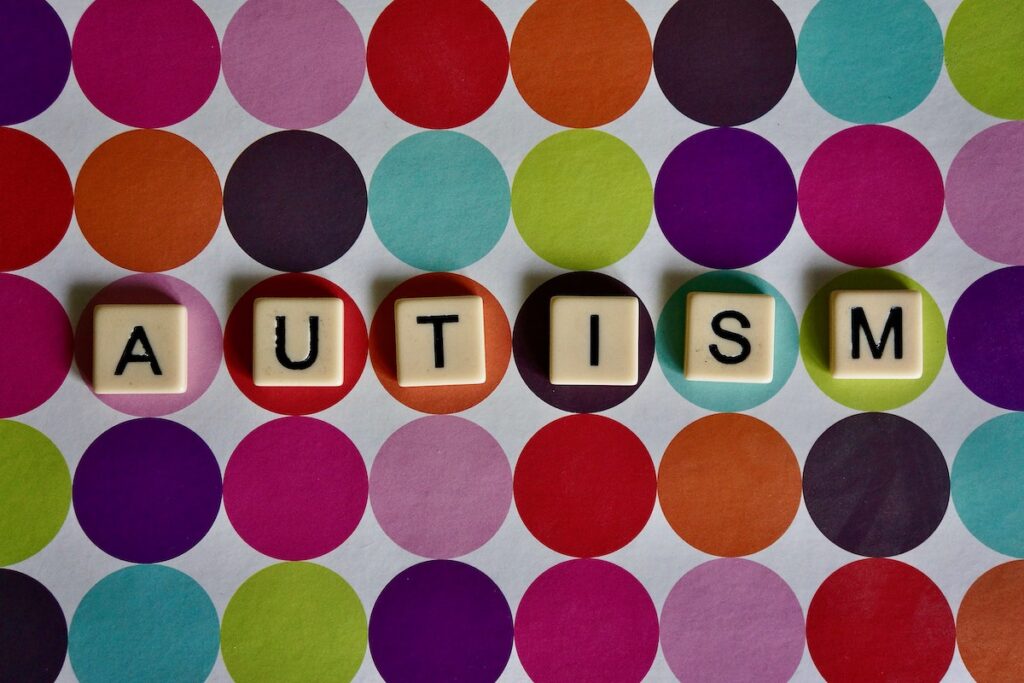
Autism is a neurodevelopmental condition, which is defined by social communication difficulties, increased sensory sensitivity, restricted interests and difficulties adapting to unexpected change (APA, 2013). The current prevalence in the general population in the UK is around 1.1%, although barriers to diagnosis remain, with a suggested large number of people being undiagnosed (Brugha et al., 2016).
In addition to this, Cassidy et al. (2014) suggest that autistic people are at significantly higher risk of experiencing suicidal thoughts and behaviours in comparison to non-autistic individuals. Autistic individuals show a higher prevalence of suicidal ideation (19.7% to 66%), and suicide attempts (1.8% to 36%) (Cassidy, 2020). Self-reported autistic trait are also associated with increased risk of suicidal behaviours and thoughts (Pelton et al., 2020). An explanation for this could be cognitive inflexibility in individuals with autism, which might make it challenging to see options out of crisis (Cassidy, 2020). Increased vulnerability to adverse events, as well as camouflaging in autistic individuals – referred to as a mechanism autistic individuals use to mask behaviours to ‘fit into society’ – are also proposed factors that increase risk of suicidality (Griffiths et al., 2019; Hull et al., 2019).
Even though autism and autistic traits increase the risk of dying by suicide (Kirby et al., 2019), there is a lack of studies that have explored undiagnosed autism. Furthermore, autistic traits in those who have died by suicide have not been quantified, which is why Cassidy et al. (2022) aimed to explore the following:
- The prevalence of autism and evidence of autistic traits in individuals who died by suicide in the UK; and
- The characteristics, as well as risk markers in autistic individuals who died by suicide in comparison to the general population.

Individuals with autism and elevated autistic traits are more likely to die by suicide than the general population.
Methods
The data was collected in two stages. In Stage 1, dates of death between 1 January 2014 and 31 December 2017 were gathered via coroners’ inquest records from two different regions of England. The Office of National Statistics 2011 census, and the Public Health England Suicide Prevention Profile (2016-2018). Records were independently identified by members of the team, where an individual likely died by suicide, and was analysed looking for evidence of autism and autistic characteristics. Evidence of autism was determined following the DSM-5 guidelines (APA, 2013). Data entry in Stage 1 took place between October 2015 and July 2019.
To analyse the coroners’ inquest, cause of death was coded using the ICD-10 definition of self-harm and suicide (WHO, 1993). A total of 372 records were identified, to analyse for evidence of self-harm and/or suicide and autism diagnosis. Disagreements between raters were solved via discussion.
In stage 2, 115 next of kin of individuals who died were invited to participate in interviews, which were identified through the coroners’ offices. The aim of the interview was to gather reasons for individuals’ death to develop preventative measures. Therefore, next of kin rated adapted versions of the social responsiveness scale – second edition (SRS-2) (Constantino & Gruber, 2012) and autism diagnostic interview revised (ADI-R) (Rutter, LeCouteur & Lord, 2003) to capture the behaviour of the person who died.
To inform the qualitative part the study, the checklist developed for evidence of autism in stage 1 was adapted. Additionally, psychological autopsy records in addition to next of kin rated SRS-2 and ADI-R were used to identify evidence for autism. Content analysis was used to identify new characteristics in autistic individuals who died by suicide.
Results
Of the 372 records, 62 (16.7%) deaths were classified as death by self-harm, and 310 (83.3%) were classified as death by suicide. Following DSM-5 guidelines, 95 records were rated for evidence of autism. Overall, 81 records (85.3%) were identified for evidence of autism between two raters.
Following chi-squared analyses, no significant difference across gender in regards to death by self-harm, suicide, autism or no autism diagnosis was observed. The overall proportion of individuals with evidence of autism was significantly higher (11.9%) than the 1.1% prevalence of autism expected in the UK. On the contrary, diagnosed individuals did not significantly differ from the prevalence of autism in the UK, and did not differ in suicide method. No risk markers between autistic and non-autistic individuals in suicide methods were reported.
In stage 2, 29 individuals took part in the interviews. The content analysis identified characteristics of those who died, such as risk markers (e.g. suicide attempts), mental and/or physical health conditions, and service contact (e.g. GP). No significant differences across identified themes were observed.
Analyses showed that individuals who died did not differ in gender or evidence of autism, but were significantly older at the time of death, in comparison to next of kin of those who died that were not invited. 12 individuals who died showed strong evidence of autism based on the coroners’ records, autopsy report and SRS-2. However, none of those reached the threshold for the ADI-R. SRS-2 scores did not significantly correlate to the evidence of autism observed in the psychological autopsy interviews.
Conclusions
- To date, this is the first study that has used a mixed-methods approach to systematically gather evidence of autism and autistic traits in individuals who died by suicide in England.
- The results suggest that evidence of autism and elevated autistic traits were present in 10.7% of those who died, which is 11 times higher than the general prevalence of autism in the UK (1.1%) (Brugha et al., 2016).
- Interestingly, the interviews in the subsample showed strong evidence of elevated autistic traits, of which 41.4% indicated possible autism. This is in line with Richards et al. (2019), who also reported high rates of elevated autistic traits in adults who attempted suicide. However, none of those identified were confirmed using the ADI-R.
- In contrast to previously reported more lethal suicide attempts in autistic individuals by Kato et al. (2013), no significant differences, nor higher numbers of risk markers were observed.
- According to these findings, autistic traits at a level for possible autism are significantly increased in those who die by suicide.
- Being diagnosed with at least one mental or physical health problem was the most commonly shared characteristic between autistic individuals who died and non-autistic individuals. This limits the possibility of unique risk markers for autistic individuals and individuals with elevated autistic traits.

Autism and autistic traits in those who died by suicide were 11 times higher than in the general population.
Strengths and limitations
The study systematically gathered evidence for autistic traits and autism diagnosis using validated autism screening and diagnostic tools. Furthermore, the study demonstrated high inter-rater reliability to ensure consistency and validity of the data when coding for and classifying autism.
However, only a small subsample of next of kin of those who showed evidence of autism identified in the study participated in the interview. Comparisons across participants were carried out to identify unique markers, but many analyses were underpowered, limiting generalisability of findings. Whilst high inter-rater reliability was ensured throughout, undiagnosed individuals cannot be confirmed, since the person who died cannot be assessed directly.
The team that completed the data entry was also involved in the interview, which increases the risk of potential bias, as well as the fact that the next of kin were only invited from one of the coroners’ offices covering one – rather than two – regions in England. Since characteristics of those tend to be slightly older, and the next of kin were predominantly female, generalisability of the findings could be limited.
Lastly, when assessing evidence for autism using the ADI-R or SRS-2 in possible autism diagnosis cases from the coroners’ record, the validated tools did not confirm the evidence of autism. Consequently, assessing autism using coroners’ records might not be valid, suggesting that further interviews are needed to obtain sufficient information.

The authors showed that undiagnosed autistic people could be at increased risk of dying by suicide and highlighted the importance of autism assessment.
Implications for practice
Individuals with autism and elevated traits are more likely to die by suicide than the general population. Since the barriers to gaining a diagnosis, as well as sufficient support remain, it is important to increase awareness and access to specialist mental health services (Cassidy, Goodwin, Robertson & Rodgers, 2021). Use of validated screening tools may improve the number of referrals and access to support (Cramm-Crosbie, 2019). In focusing on removing barriers to receiving treatment, individually tailored support programmes should be developed and offered to autistic individuals. Facilitating mental health support may enable autistic individuals to reach out in crisis, to reduce autistic individuals’ high risk of suicide (Cassidy et al., 2021) and prevent suicide.

Implementation of screening tools may help to identify autistic individuals early, to provide post-diagnosis support and to reduce risk of suicide.
Statement of interests
None.
Links
Primary paper
Cassidy, S., Au-Yeung, S., Robertson, A., Cogger-Ward, H., Richards, G., Allison, C., Bradley, L., . . . & Baron-Cohen, S. (2022). Autism and autistic traits in those who died by suicide in England. The British Journal of Psychiatry, 1-9. Doi: 10.1192/bjp.2022.21
Other references
American Psychiatric Association. Diagnostic and Statistical Manual of Mental Disorders (DSM-5). American Psychiatric Association, 2013. https://doi.org/10.1176/appi.books.9780890425596
Brugha TS, Spiers N, Bankart J, Cooper SA, McManus S, Scott FJ, et al. (2016). Epidemiology of autism in adults across age groups and ability levels. British Journal of Psychiatry 209, 498–503. https://pubmed.ncbi.nlm.nih.gov/27388569/
Camm-Crosbie L, Bradley L, Shaw R, Baron-Cohen S, Cassidy S. (2019). ‘People like me don’t get support’: autistic adults’ experiences of support and treatment for mental health difficulties, self-injury and suicidality. Autism, 23, 1431–41. https://doi.org/10.1177/1362361318816053
Cassidy, S. (2020). Suicidality and self-harm in autism spectrum conditions. In Oxford Handbook of Autism and Co-Occurring Psychiatric Conditions (p.349–68). Oxford University Press.
Cassidy, S., Bradley, P., Robinson, J., Allison, C., McHugh, M. & Baron-Cohen, S. (2014). Suicidal ideation and suicide plans or attempts in adults with Asperger’s syndrome attending a specialist diagnostic clinic: a clinical cohort study. Lancet Psychiatry, 1, 142-147. https://pubmed.ncbi.nlm.nih.gov/26360578/
Cassidy S, Goodwin J, Robertson A, Rodgers R. (2021). INSAR Policy Brief: Autism Community Priorities for Suicide Prevention. International Society for Autism Research.
Constantino, J.N. & Gruber, C.P. (2012). Social responsiveness scale: SRS-2. Western Psychological Services. http://kkjp.devswitch.nl/wp-content/uploads/2018/04/Social-Responsiveness-Scale-SRS.pdf
Griffiths, S., Allison, C., Kenny, R., Holt, R., Smith, P. & Baron-Cohen, S. (2019). The vulnerability experiences quotient (VEQ): a study of vulnerability, mental health and life satisfaction in autistic adults. Autism Research, 12, 1516-1528. https://doi.org/10.1002/aur.2162
Hull, L., Mandy, W., Lai, M.C., Baron-Cohen, S., Allison, C., Smith, P., & Petrides, K. V. (2019). Development and validation of the camouflaging autistic traits questionnaire (CAT-Q). Journal of Autism and Developmental Disorders, 49, 819-833. https://doi.org/10.1007/s10803-018-3792-6
Kato, K, Mikami, K., Akama, F., Yamada, K., Maehara, M., Kimoto, K, Kimoto, K., . . . & Matsumoto, H. (2013). Clinical features of suicide attempts in adults with autism spectrum disorders. General Hospital Psychiatry, 35, 50-53. https://doi.org/10.1016/j.genhosppsych.2012.09.006
Kirby, A.V., Bakian, A.V., Zhang, Y., Bilder, D.A., Keeshin, B.R. & Coon, H. (2019). A 20-year study of suicide death in a statewide autism population. Autism Research, 12, 658-666. https://doi.org/10.1002/aur.2076
Office of National Statistics (2011). Retrieved from: https://www.ons.gov.uk/census/2011census
Pelton, M.K., Crawford, H., Robertson, A.E., Rodgers, J., Baron-Cohen, S. & Cassidy, S. (2020). Understanding suicide risk in autistic adults: comparing the interpersonal theory of suicide in autistic and non-autistic samples. Journal of Autism and Developmental Disorder, 10, 3620-3637. https://doi.org/10.1007/s10803-020-04393-8
Public Health England Suicide Prevention Profile (2016– 2018). Retrieved from: https://www.gov.uk/government/statistics/suicide-prevention-profile-updates
Richards G, Kenny R, Griffiths S, Allison C, Mosse D, Holt R., O’Connor, R. C., Cassidy, S. & Baron-Cohen, S. (2019). Autistic traits in adults who have attempted suicide. Molecular Autism, 10. https://doi.org/10.1186/s13229-019-0274-4
Rutter, M., LeCouteur, A. & Lord, C. (2003). Autism Diagnostic Interview-Revised Manual. Western Psychological Services. https://doi.org/10.1007/978-1-4419-1698-3_894
World Health Organization. The ICD-10 Classification of Mental and Behavioural Disorders: Diagnostic Criteria for Research. World Health Organization, 1993. https://apps.who.int/iris/bitstream/handle/10665/37108/9241544554.pdf
Photo credits
- Photo by Peter Burdon on Unsplash
- Photo by Tom Barrett on Unsplash
- Photo by Jason Blackeye on Unsplash
- Photo by Raj Rana on Unsplash
- Photo by Debby Hudson on Unsplash
- Photo by Ann Fossa on Unsplash

Thank you for an interesting discussion of a paper, Shania!